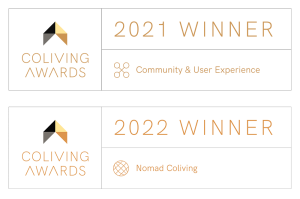“Have you ever thought about opening your own coliving?”
I’ve lost count of the times I’ve been asked this. My usual answer, often with a laugh, is: “Nah, I know the work behind it!”
There’s truth in the joke. But to be honest? Yes, the thought has crossed my mind many times. And it’s still something I might consider one day.
After more than four years in the coliving industry, I’ve realised that not everyone truly understands what goes into creating and maintaining these spaces. Guests, colivers, or “unicorns” (call them what you will!) often only see the surface: the friendly host, the seamless community. But behind the scenes, there’s a world of effort that makes it all possible.
Here, I wanted to share my journey—not to scare off those dreaming of opening their own coliving, nor to sell them on the idea, but to provide insight for anyone curious about the realities.
To set things straight beforehand, with the term “coliving” I here refer to shared living spaces designed for professionals, creatives, and digital nomads—people who value not just a place to live, but a community to belong to.
The notes, learnings, and thoughts below are derived from my personal and professional experience—they may not be universal, but they’re authentic to what I’ve seen and lived.
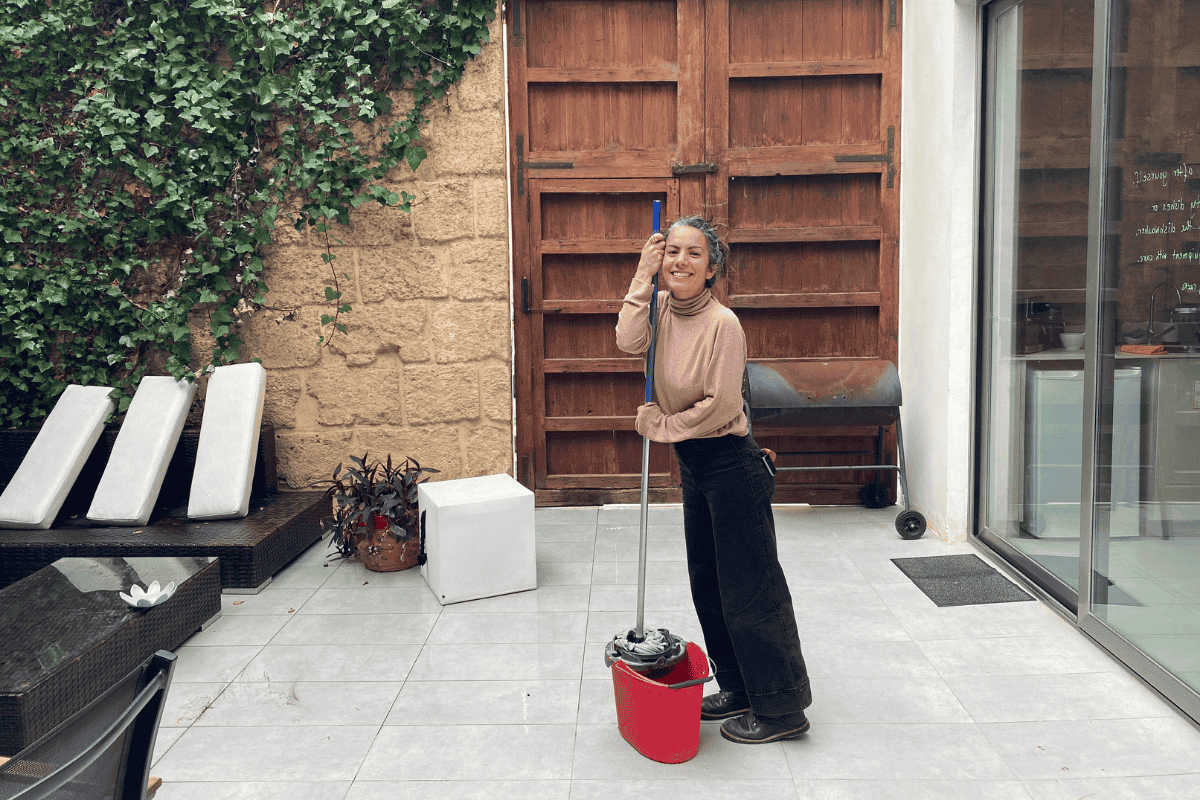
Me cleaning up the floor
My Random Story in Brief
Yes, my landing in the coliving world was, as I like to define it, random.
Before 2020, I barely knew what digital nomads were, let alone that coliving spaces existed. I’d just quit my corporate job at the end of 2019 and was travelling solo through Southeast Asia, backpack in hand, when COVID-19 happened.
Stranded in Thailand for six months, I completed a Yoga Teacher Training course and began exploring ways to stay put while figuring out my next steps. That’s how I found myself at Nine Coliving in Tenerife as a yoga volunteer in December 2020. I planned to stay for three months. I stayed for over two years. Life, eh?
From there, I travelled and worked at other colivings: Dwell Coliving in the Azores, Cloud Citadel in the French Alps, and Sun and Co. in Spain, where I now work full-time. I also had the chance to be a guest in EcoIsleta and connect directly with many others working in the same field. These experiences allowed me to see how different spaces operate and gave me a deeper understanding of what it takes to create successful coliving communities.
Through the years I had the chance to experience different settings in different places.
Here are some common variations I came across:
- Volunteer or no volunteer? Some spaces include volunteers; others don’t. Most of the time this depends on how established the place is—a new space often doesn’t have an initial budget to hire an employee from the beginning.
- Owner involvement: Owners may be highly hands-on—or hardly involved. This is very much linked to the presence of volunteers and/or employees.
- Community dynamics: Some spaces adopt a bottom-up structure, where colivers organize activities, while others prefer a more top-down approach led by the team.
- Housekeeping roles: Staff responsibilities for cleaning and maintaining spaces vary widely.
The reasons for the above can be personal, or financial, depending on each space.
Art of Co. is a great resource to touch base on different structures – including a broader sense of the word “coliving”.
It wasn’t until I started my position at Sun and Co., that I realised this was actually my job now – I was a community manager, a host and a facilitator. So, why did it take me more than two years to realise that? I can confidently say that the struggle I had in separating personal and professional, was a key element in this.
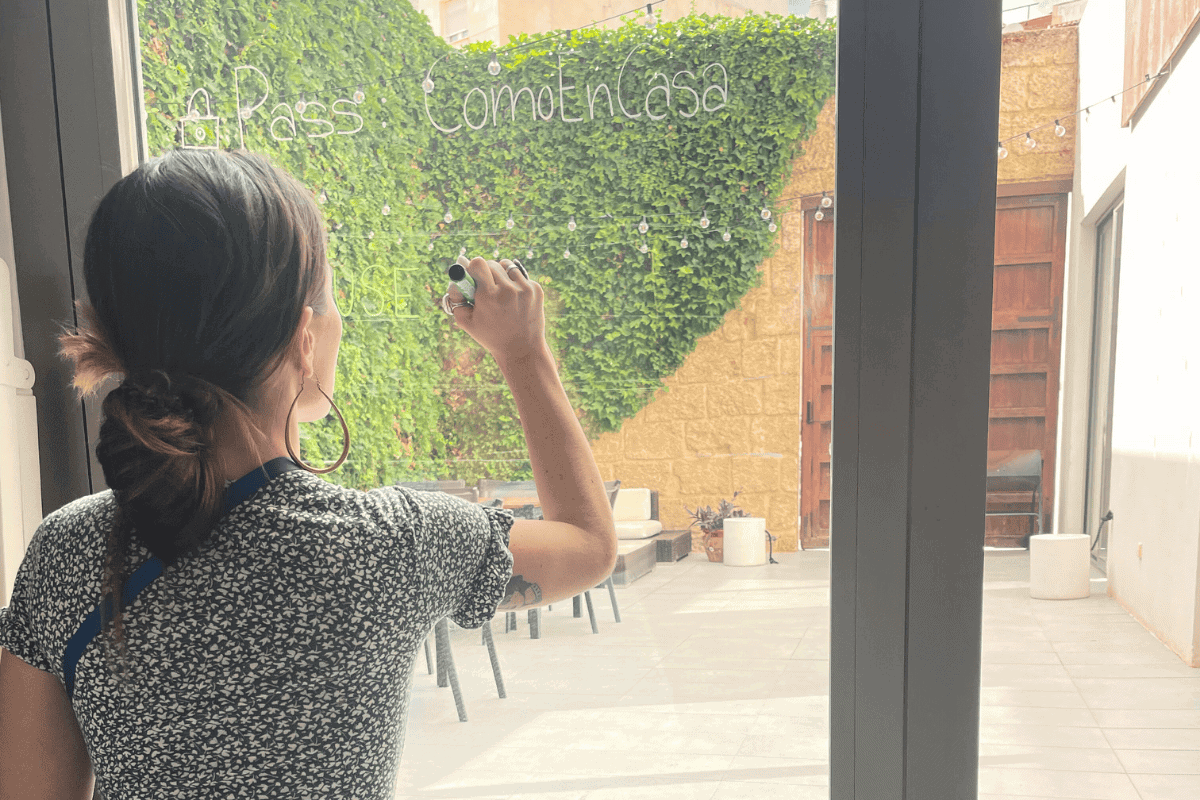
Team member preparing our informative windows
The Job That Doesn’t Feel Like A Job
When I first arrived at Nine Coliving, I was in the midst of a major life change. The support, encouragement, and inspiration I found from the people around me were incredible and very quickly I was completely immersed in community life. From organizing hikes to being a sous-chef at family dinners, my work seamlessly blended with social interactions. It didn’t feel like a job at all.
I was living in the house and I would joke at dinner time, “I’m working—I’m the host tonight!”. But this dynamic also blurred boundaries, and balancing social and professional roles quickly became trickier than I thought.
Everything felt simply wonderful…until reality showed the more difficult side of things.
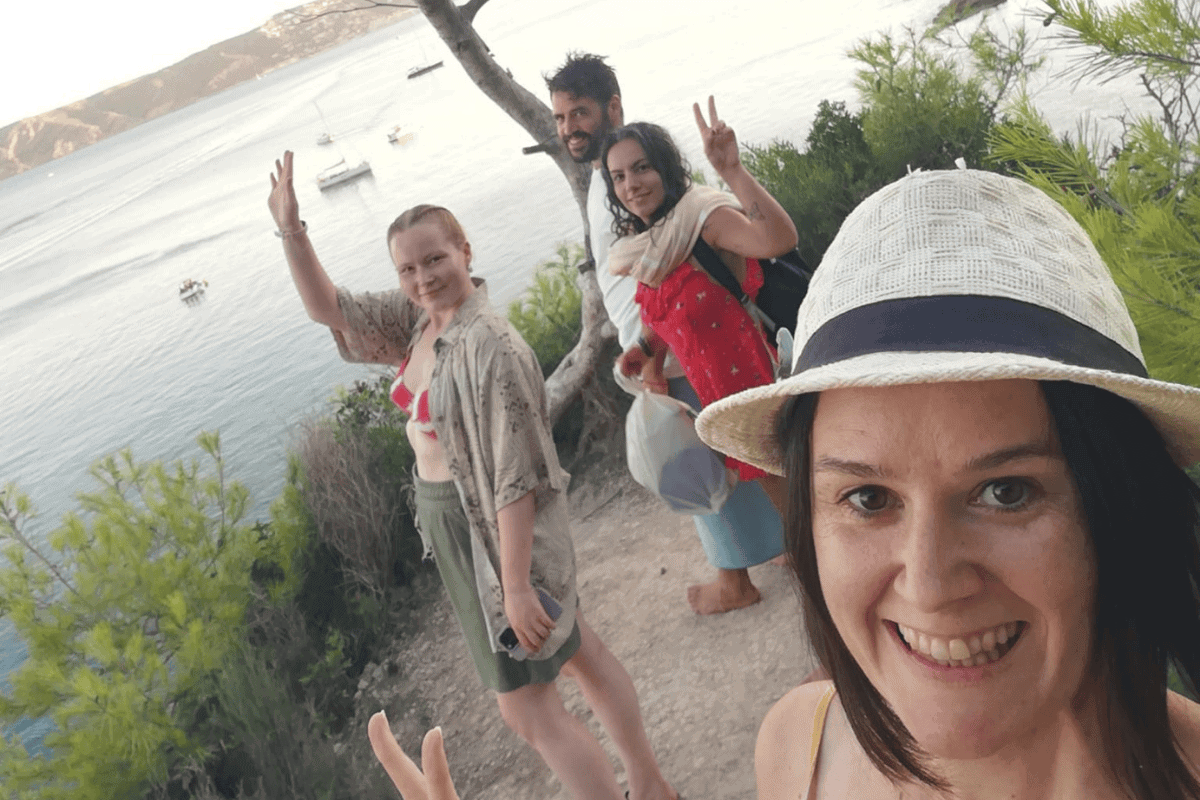
Sun and Co. team on an excursion
Biggest Challenges
Working in a coliving space comes with its fair share of challenges. It’s not all sunsets, laughter, and deep conversations—although those moments are certainly a big part of it. Alongside the rewards, there are obstacles that require patience, adaptability, and a deep understanding of both yourself and the people around you.
Here are a few things that put me on the spot:
- Friendship vs. Business: With time, you create real friendships with some people, and handling those when they are part of the community as guests, can be challenging at times.
- Getting personal, but not too personal: Living with the community means friendships, disagreements, and even love stories can arise. Learning to set boundaries and navigate these situations takes time and self-awareness.
- Not everyone will love your space: It’s tough to accept that some guests won’t vibe with the place you call “home”. It can take time to embrace that your community isn’t for everyone, just as you won’t love every community you visit.
- You are in disagreement: I often find myself disagreeing—with the way some people approach travel or even with the way certain things are handled within the space itself. Navigating these moments is a delicate art. Understanding where to draw the line when bringing up conversations, while still ensuring guests feel welcome, can be incredibly tricky. At the same time, if you’re working in a space that isn’t your own, there will be times when you must accept that you can’t change everything.
Learning to adjust to all these situations without compromising your own values is key. Losing sight of what matters to you can lead to dissatisfaction. This will impact yourself but also directly reflect on the way you work with the community and therefore affect its wellbeing. You can see how important it is to strike a balance between flexibility and staying true to yourself.
But the one thing that for me played a significant role and that brought to me most learnings and readjustments was realising I was going down the rabbit hole of social burnout.
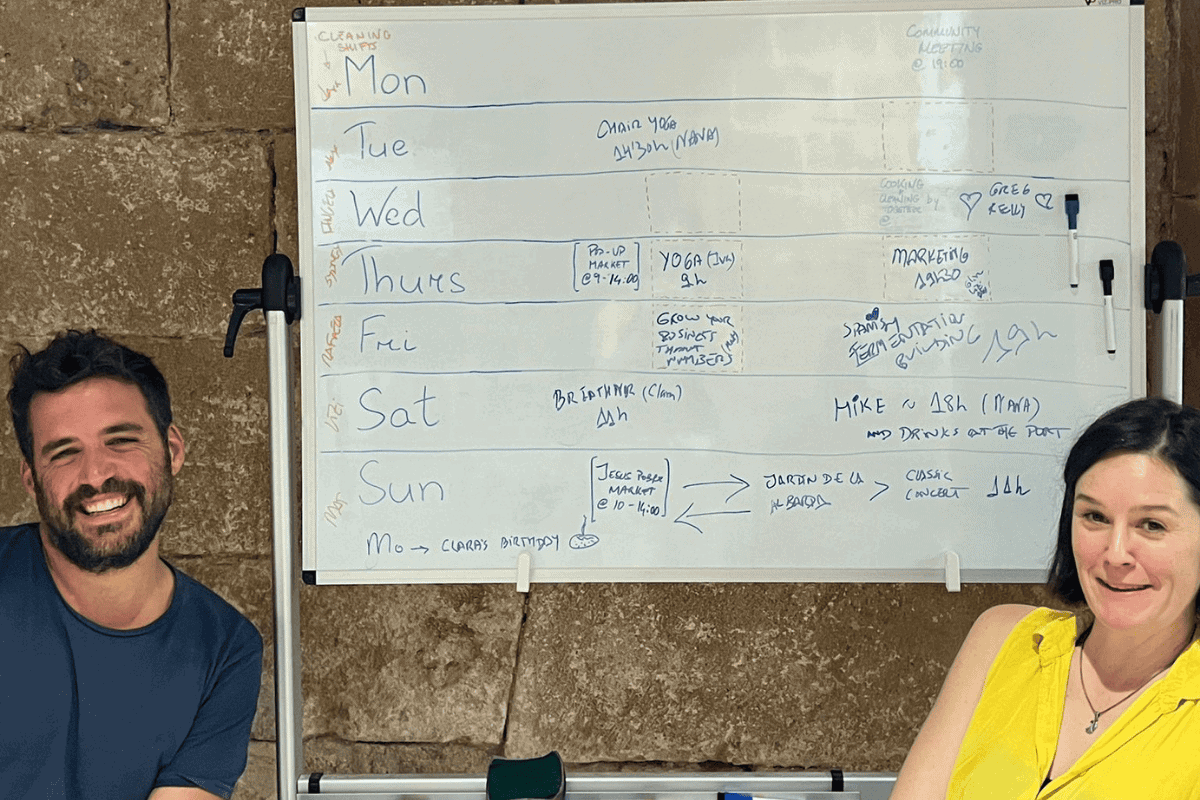
Sun and Co. team leading the Monday Community Meeting
Beware of Social Burnout
As someone who has often been called a “social butterfly” by friends and colleagues, realizing I was experiencing social exhaustion came as a shock. It didn’t happen all at once—it crept up on me.
At first, I just felt tired but restless. I couldn’t seem to relax, and my focus on the things that mattered to me began to slip. I was saying yes to everything, constantly surrounded by people, and always on the move. Slowly, I noticed that my ability to simply be—to unwind and tune in to myself—had disappeared. My energy was depleted, and I was losing sight of my own needs.
In a coliving environment, the only constant is often change. Guests come and go, new faces replace old ones, and just when you’ve built a sense of stability, the dynamic shifts again. These constant transitions can be both exhilarating and exhausting, often adding to a feeling of instability, especially if you’re craving deeper, long-term connections.
For me, the symptoms were subtle, yet I could feel something was off: difficulty concentrating, an underlying sense of exhaustion, and a lack of motivation at times. I’ve always thrived in social settings, I know that by nature community living is the way to go for me and assumed that being in a group would naturally recharge me. And while that’s true to an extent, I learned that I can only maintain that energy if I balance it with intentional downtime. Sometimes, all I needed was a quiet evening alone to reset.
I’ve seen others in this line of work struggle with social exhaustion on a much deeper level. Some have reached the point of near-total withdrawal from the community, unable to cope with the unrelenting pace of constant social engagement. This happens quickly in a job like this: you might start with incredible energy and enthusiasm, but without clear boundaries, a life outside the community, and regular self-check-ins, social burnout is almost inevitable.
An extra shout-out goes to the ones living inside the coliving walls. When your home is also your workplace, maintaining a healthy separation between the two can feel impossible. The lines blur easily, and if you’re not careful, you can find yourself working 24/7 without realizing it—been there, done that! Especially when you’re new to this, you might feel an unspoken pressure to always “be on” for the community—social, engaged, and available. The mental and emotional toll of this overlap is real, which is why setting boundaries (and sticking to them!) is non-negotiable.
While it is true that being an extrovert by nature will give you some sort of advantage in doing this job—introverts might find it easier and more natural to set these boundaries. Both can be successful community managers if they find a way that works for them to balance out their needs.
Over the years, I have adapted my way of being with the community, making sure it remains a space for me to enjoy rather than to escape from. A place that nourishes me rather than drains me. It’s a work in progress that saw me making small adjustments in my attitude, my way of communicating and also the expectations I had on how I thought this job had to be done.

Myself leading an extra skillshare session
Challenges come (hopefully!) with learnings. Each space I’ve worked in has taught me something valuable depending on which stage of my journey I was in.
In Part 2, I go through my learnings, strategies I have learned over the years as well as final considerations on what I truly believe is one of the best jobs I have ever had the pleasure to do!




